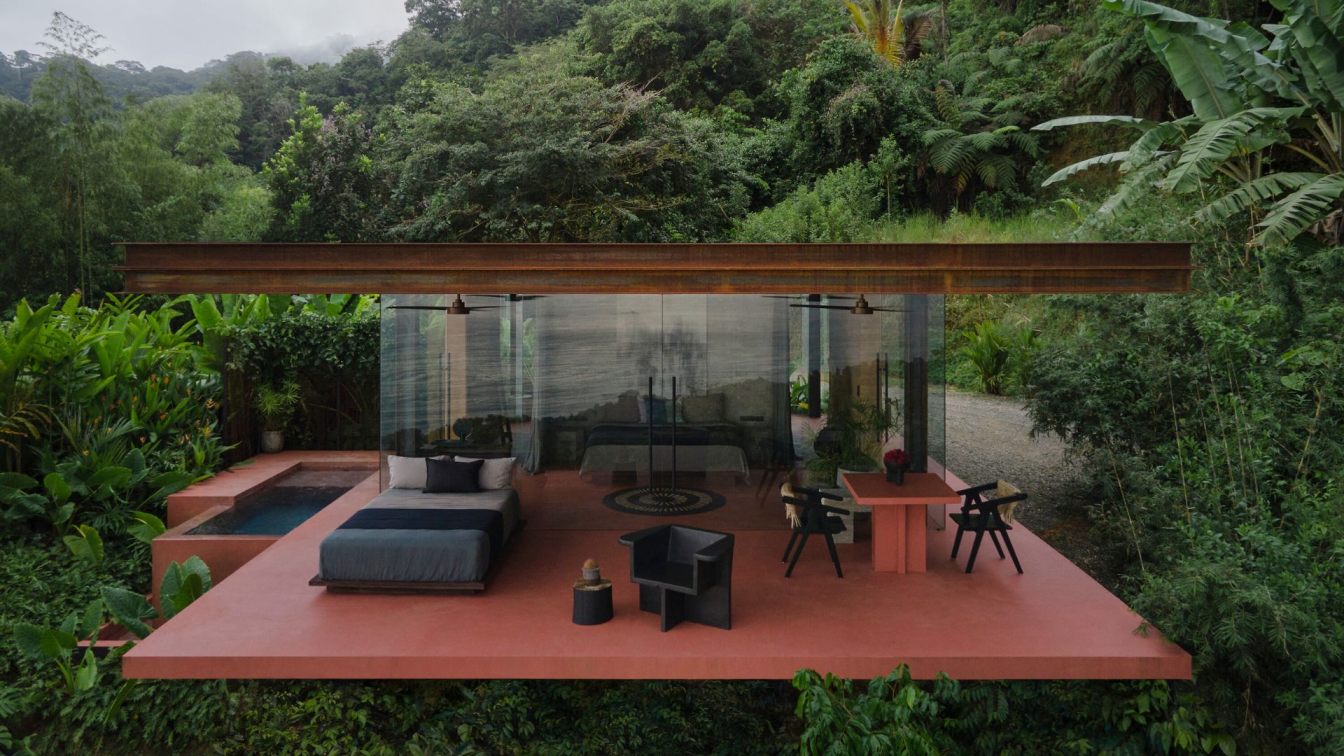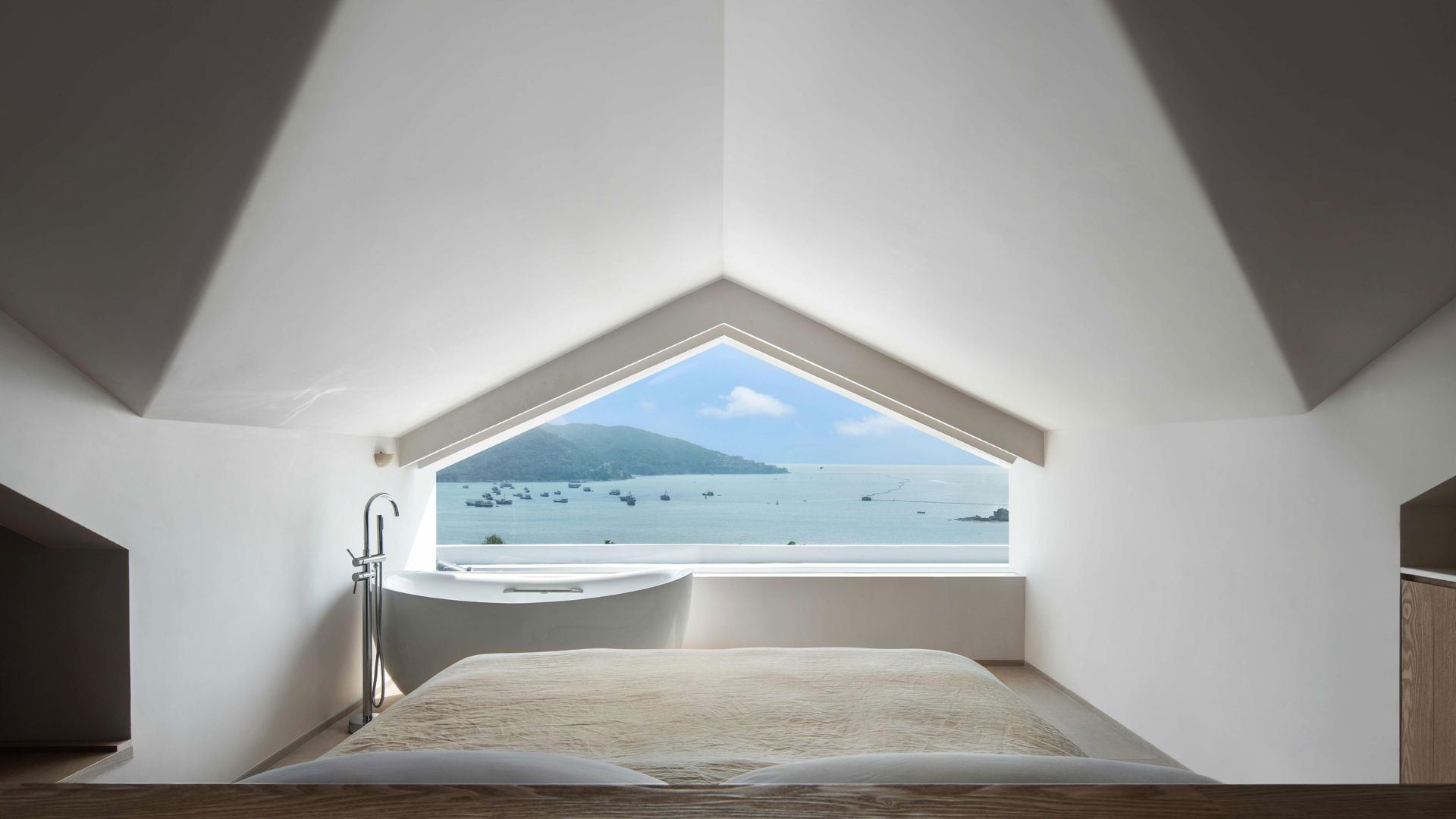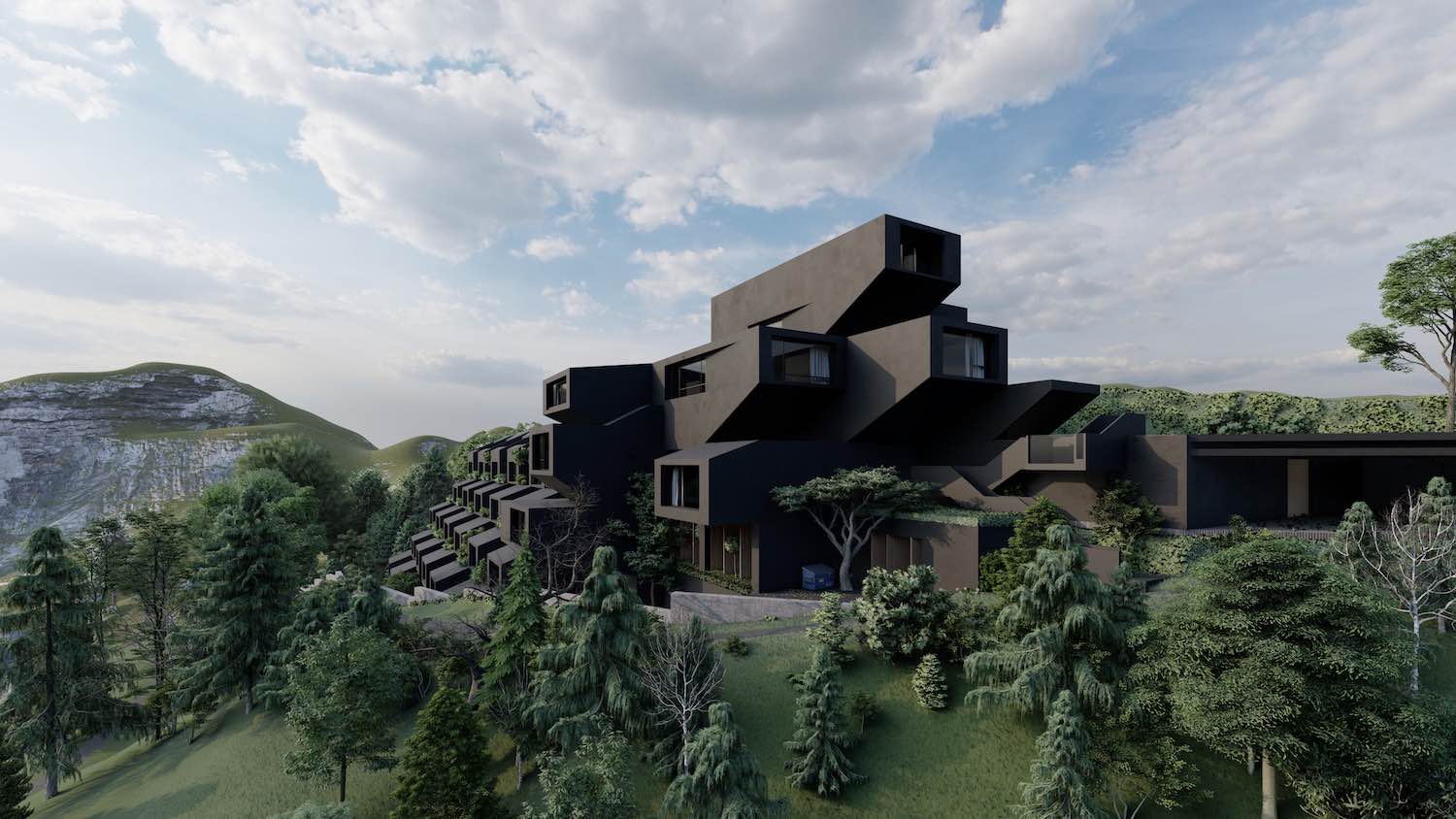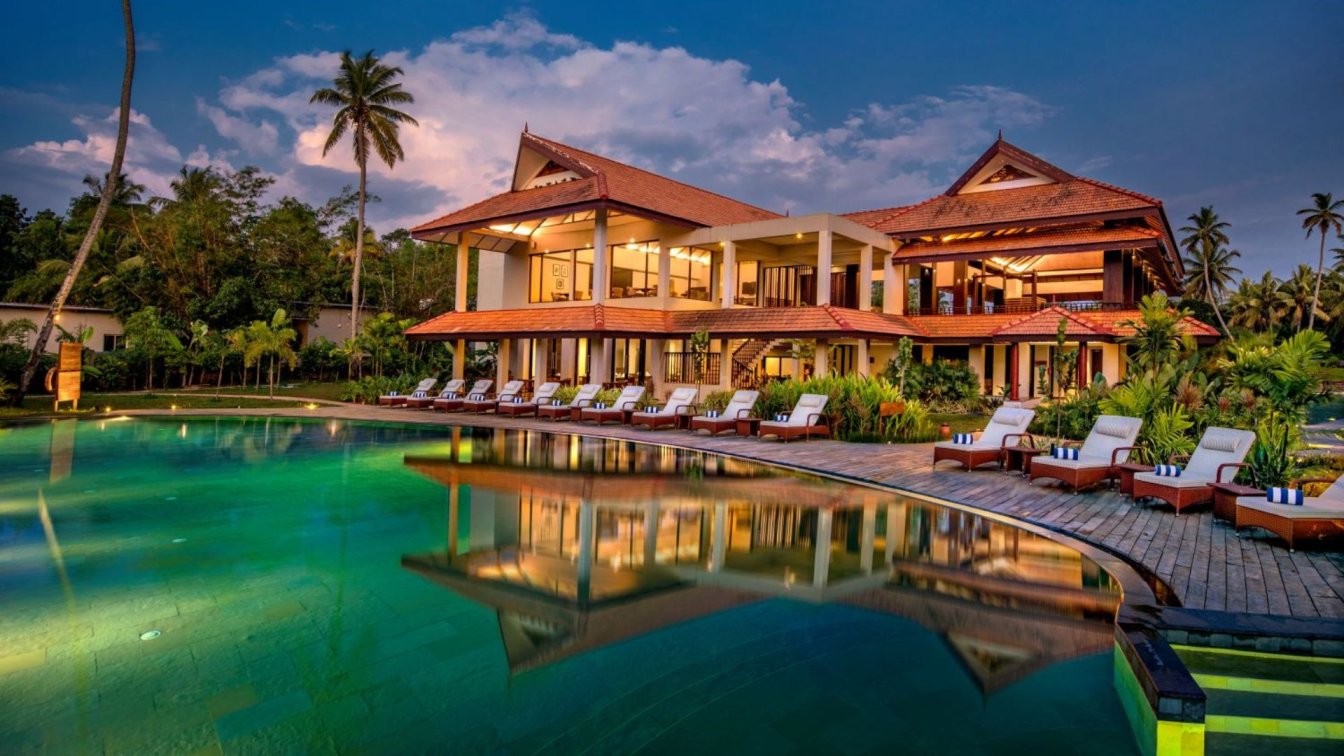Formafatal: This project is the very first “rammed earth” implementation in Costa Rica. We completely used clay soil from the excavations for the construction of all perimeter bearing walls.
Near Uvita town, on a plot of 11,000 square meters at a height of 300 m above the sea, I designed two small villas on a hill overgrown with a jungle. Both villas, partly levitating above the steep southern slope, are designed for short-term recreational rentals. The built-up area of each of them is 90 m2.
My intention was to design sustainable houses with biophilic interiors, which will be sophisticatedly thought-up and at the same time their shaping will be strongly minimalist and simple. No unnecessary extra element, but also nothing to miss.
The architecture of villas is deliberately with its thin and sharp lines in contrast to lush tropical vegetation, but the chosen materials and colors are perfectly coinciding with the surroundings.
Both villas are architecturally the same. Materials, floor plan layout, or orientation towards cardinal points are also identical. However, it differs in the interior, especially by its color concept, which is partly reflected also in exteriors.
The architectural design is based on the genius loci - on the orientation of the building plot towards the endless view of the Pacific Ocean and the morphology of the terrain.

The color concept of interiors responds to the energies that were perceived in the location of the villas before their construction.
Although the villas are only 12 m apart, each of them has clearly different vibrations that I reflected into the interior design.
Jaspis Villa (jaspis = jasper, bright villa) is a reflection of yin energy. It is connected to the ocean and sky, not only visually, but also its vibrations. With a color concept in sand shades, I respond to this interconnection.
Nefrit Villa (nefrit = jade, dark villa) is a reflection of yang energy. In the Nefrit villa you can feel the connection with the ground and the jungle. Here, too, the chosen color concept is reaction to these energies and the red-terracotta color of the concrete floor transmits the shade of local soil to the interior of the house.
Upon arrival, both villas seem very inconspicuous, humble. On the sides they are lined with newly planted tropical plants. But as soon as you pass through the villa, further towards the levitating terraces, after a few steps, the view of the ocean is opening, and you will find yourself in the generous space of the main bedroom with adjacent terraces and infinity plunge pool.
As if you suddenly find yourself in a different villa other than you entered.

I put an extreme emphasis on all construction – architectural details and their mutual constraints. The raw visual materials of rammed earth walls and concrete are complemented by the structural steel H-beams, supporting a concrete monolithic ceiling slab. The girders and ring beam of the house are visible only in the upper face of the roof, which is lined with a pair of steel “U” profiles. They also fulfill the function of the roof attic.
All facades oriented to endless views of the ocean are designed from frameless glass. The profiles of sliding and solid parts of the glass facades are recessed into the grooves in the concrete ceiling slab. In this way was also applied the installation of interior lighting rails and the connecting rail for the mosquito net and the curtains around the bed. The concrete floor slab is covered with a non-slip structured cement screed, which is different in each villa. The remaining interior walls including concrete custom-designed solid furniture, are also in the surface of cement screeds, but here in smooth matte finish.
I chose the materials as durable as possible considering the Costa Rican climate and high humidity. To realize the clay "Rammed Earth" walls I invited an experienced specialist from Brazil, the owner of Terra Compacta company, because in Costa Rica no one had any experience with this construction method. Daniel Mantovani from Terra Compact trained several local craftsmen and together they can attribute their first place to realize Rammed Earth architecture in Costa Rica.
Minimalist architecture is also reflected in interiors, where there is no door except for the large-format sliding panel in the section of the shower and toilet. It also fulfills the function of a hanger wall with a large mirror. The equipment of the interiors is mostly custom-made. Kitchen desk, sink, shelves, solitary bedside tables or bench are made from concrete. For some of the concrete solitaires, I was inspired by the work of the Belgian design studio Bram Vander-Beke. The creation of this studio is very close to me. Other furniture, luminaires, accessories and art were carefully selected with regard to originality, often directly from designers across all continents. The architect of the project Achioté worked at the same time as co-investor, project manager and construction manager.































































About studio
Architect Dagmar Štěpánová is the founder and principal architect of the internationally awarded architectural studio Formafatal.
She founded the studio in 2015 and currently employs an 11-member team. She has offices both in Prague and Costa Rica, where she has moved. In addition to her architectural activities, she operates the rental of exclusive villas in the Costa Rican jungle, of which she is a co-investor.
In 2020, the Formafatal studio became the winner of THE INTERIOR DESIGNER OF THE YEAR 2020 in the prestigious international competition DEZEEN AWARDS 2020 and in the same year won another prestigious award in the ARCHITIZER AWARDS 2020 for the Atelier Villa Costa Rica.
The studio gained other awards for the projects Art Villas Costa Rica, Wine Bar Autentista, Moon Club Night Club, private apartment Loft Hřebenky, or for the Argentine restaurant Gran Fierro.
Currently, Formafatal has been working on several commercial and residential projects not only in the Czech Republic but across the world.
We're a team of friends – architects, designers, and scenographers. We're a creative studio focused on architecture, interior design, exhibition installation, and product design.
We create public spaces, where people feel cozy, and homes, that are tailored to the clients needs. All projects we approach individually and with focus on specific human needs and client’s requirements. Individual approach for each project is based on mutual understanding with the client, enthusiasm, natural collaboration, and unified conceptual solutions. We solve projects complexly from creative concept to realization, with attention to detail.
The emphasis on sustainability is a matter of course in our projects. In our approach to architecture, we also consider and accentuate historical values that we always try to preserve. Through its projects, the studio seeks to motivate other architects and their clients to approach projects with respect to the environmental problem.
Bio – Dagmar Štěpánová
Dagmar Štěpánová graduated at the Faculty of Architecture at Czech Technical University in Prague. In 2015, after twelve years of experience in the field, she founded her own studio Formafatal.
The architect carefully chose each member of the team and claims that together they form an amazing team. Formafatal is like a family to her. The 11-member team of architects, scenographers, and designers currently works on several commercial and residential projects not only in the Czech Republic but across the world. Formafatal has won several domestic and international awards.
Already during her studies, the architect liked the culture and architecture of South and Central America. In her professional life, her dream came true with the project Art Villas Costa Rica. In the end, Dagmar moved permanently to Costa Rica and, besides the Achioté project, works on several other Costa Rican projects - from residential villas to Yoga -Retreat Center.





